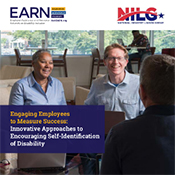
Strategies for Increasing Self-Identification of Disability
 Today, more and more businesses both large and small are recognizing the value of an inclusive workforce for people with disabilities and using a variety of innovative strategies to bring them on board. This includes proactively taking steps to recruit and retain qualified people with disabilities.
Today, more and more businesses both large and small are recognizing the value of an inclusive workforce for people with disabilities and using a variety of innovative strategies to bring them on board. This includes proactively taking steps to recruit and retain qualified people with disabilities.
Moreover, some companies are required to do such. Specifically, under Section 503 of the Rehabilitation Act, federal contractors with 50 or more employees and a contractor of $50,000 or more must have affirmative action programs for the inclusion of people with disabilities.
In either situation, the primary method for measuring progress is to invite applicants and employees to self-identify as having a disability. Now, a new guide helps employers understand strategies they can use to encourage employees with disabilities to self-identify, whether they're doing so for voluntary or required affirmative action purposes. Specifically, Engaging Employees to Measure Success: Innovative Approaches to Encouraging Self-Identification of Disability provides ideas for how to counter what research shows to be the main barriers to self-identification. It also includes examples of innovative approaches businesses have used to increase self-identification rates.
Published by the ODEP-funded Employer Assistance and Resource Network on Disability Inclusion in collaboration with ODEP's Alliance partner the National Industry Liaison Group, this new guide can be a valuable resource for businesses of all sizes interested in assessing their progress toward disability-inclusion goals.
Self-identification is about more than reaching certain numbers, however. Done right, the very act of inviting applicants and employees to self-identify helps convey that a company intends to not just express a commitment to an inclusive workforce, but also deliver on it.
For additional news and resources, sign up for ODEP's email updates.
